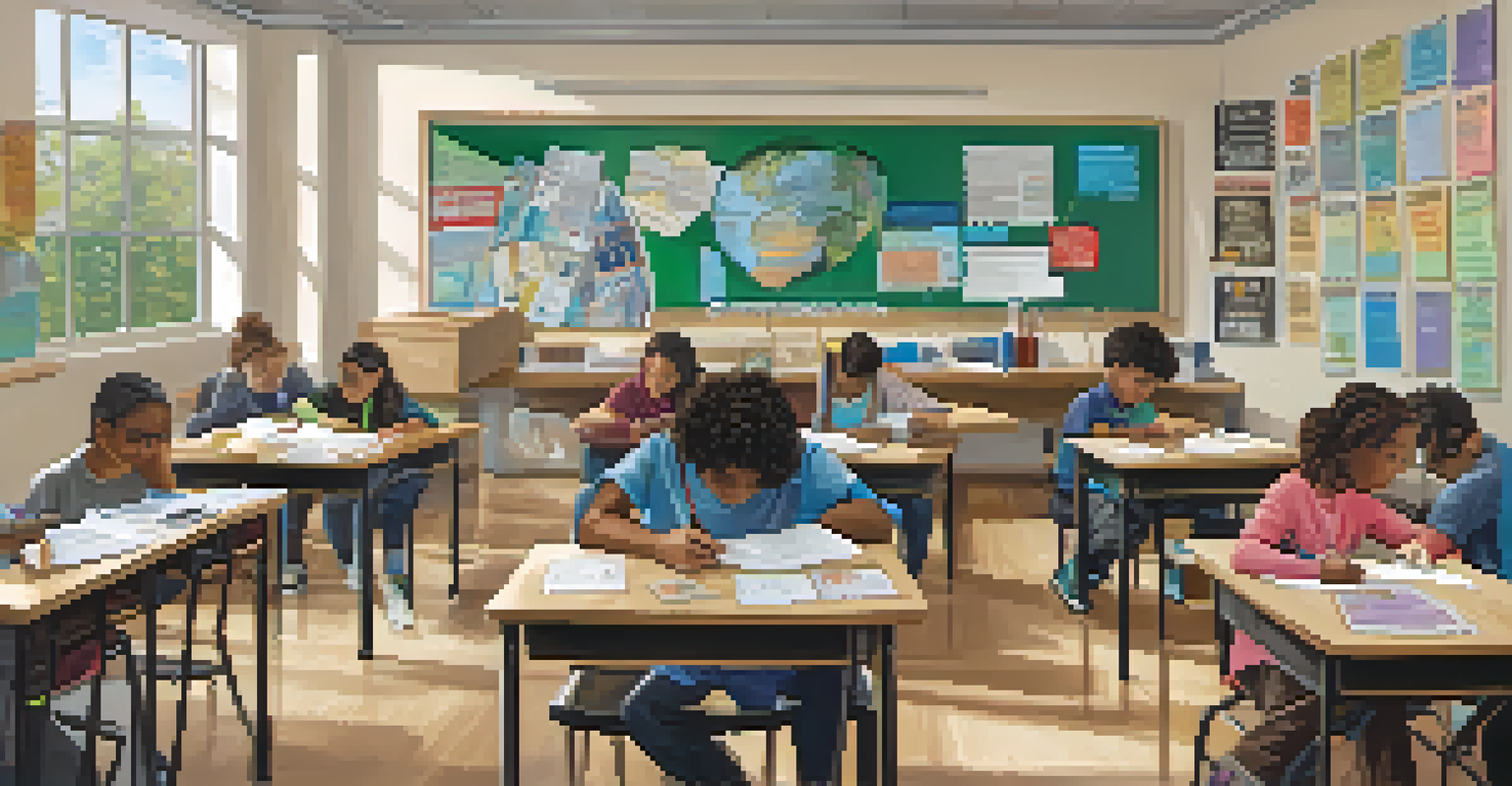Integrating Collaborative Learning with Service Learning Projects

Understanding Collaborative Learning and Its Benefits
Collaborative learning is a teaching approach where students work together to solve problems or complete tasks. This method not only fosters a sense of community but also encourages critical thinking and communication skills. When students collaborate, they can share diverse perspectives that enhance the learning experience.
Alone we can do so little; together we can do so much.
One major benefit of collaborative learning is that it prepares students for real-world scenarios, where teamwork is essential. For instance, in a corporate setting, employees must often collaborate to achieve common goals. By practicing these skills in an academic environment, students become more adaptable and effective team members.
Moreover, collaborative learning can boost student engagement. When individuals feel that their contributions matter, they are more likely to participate actively. This sense of belonging can lead to improved academic performance and greater satisfaction with the learning process.
What Is Service Learning and Its Importance?
Service learning combines community service with academic instruction, allowing students to apply what they learn in the classroom to real-world challenges. This form of experiential education emphasizes civic responsibility, fostering a sense of social awareness among students. By engaging in service projects, students gain firsthand experience in addressing community needs.

The importance of service learning lies in its dual focus: it benefits both the community and the students. For instance, while students provide valuable assistance to local organizations, they also develop essential skills such as empathy, problem-solving, and leadership. This reciprocal relationship enhances the educational experience and cultivates a sense of purpose.
Benefits of Collaborative Learning
Collaborative learning enhances critical thinking and communication skills while preparing students for real-world teamwork.
Additionally, service learning promotes active citizenship. Students become more aware of societal issues and are encouraged to think critically about their roles within their communities. This increased awareness can inspire lifelong commitments to service and social justice.
The Synergy Between Collaborative Learning and Service Learning
Integrating collaborative learning with service learning creates a powerful educational experience. When students work together on service projects, they not only apply academic concepts but also learn from each other's experiences and insights. This collaboration can lead to more innovative solutions to community issues.
The best way to find yourself is to lose yourself in the service of others.
For example, in a group project addressing food insecurity, students can leverage their diverse backgrounds and skills to devise effective strategies. Through this process, they enhance their problem-solving abilities while making a tangible impact on their community. The result is a deeper understanding of both the service and the collaborative process.
Furthermore, this integration encourages peer-to-peer learning. As students collaborate, they share knowledge and skills, which can lead to a richer understanding of the subject matter. This dynamic interaction can significantly enhance the overall educational experience.
Designing Collaborative Service Learning Projects
To create effective collaborative service learning projects, educators must first identify community needs that resonate with students' interests. This engagement ensures that students are motivated and invested in the outcomes of their work. For instance, a project addressing environmental sustainability might attract students passionate about ecology.
Next, it's essential to structure the project around specific learning objectives. By clearly defining what students should learn and achieve, educators can guide the collaborative process more effectively. This clarity helps students understand the relevance of their work and how it contributes to their overall education.
Importance of Service Learning
Service learning fosters civic responsibility and social awareness, benefiting both students and the community.
Lastly, regular reflection sessions should be incorporated into the project. These moments allow students to discuss their experiences, challenges, and successes, fostering a deeper understanding of the collaborative learning process. Reflection can be a powerful tool for growth, helping students connect their service experiences to their academic learning.
Challenges in Integrating Collaborative and Service Learning
Despite the numerous benefits, integrating collaborative learning with service learning can present challenges. One common issue is the varying levels of commitment among students. While some may be eager to engage, others may be less motivated, leading to imbalances in group dynamics.
Additionally, logistical challenges such as coordinating schedules and securing community partnerships can hinder project success. Educators must be proactive in addressing these issues, ensuring that all students have equal opportunities to participate and contribute. This may involve flexible scheduling or additional support to facilitate collaboration.
Furthermore, assessing student learning in a collaborative service project can be complex. Traditional grading methods may not adequately capture individual contributions and learning outcomes. Educators should consider alternative assessment strategies, such as peer evaluations or reflective journals, to provide a more comprehensive evaluation of student performance.
Real-World Examples of Successful Integration
Many educational institutions have successfully integrated collaborative learning with service projects. For example, a university may partner with local non-profits to develop a community garden, where students work together to cultivate plants while learning about sustainability. This hands-on project fosters teamwork and teaches essential skills like project management and communication.
Another example is high school students collaborating with local hospitals to create awareness campaigns about health issues. By working in teams, students can combine their ideas and creativity to develop impactful messages. This not only benefits the community but also enhances their understanding of public health and advocacy.
Integrating Learning Approaches
Combining collaborative and service learning enriches educational experiences, encouraging innovation and peer-to-peer learning.
These examples highlight the potential for transformative learning experiences when collaboration meets service. The benefits extend beyond the classroom, equipping students with skills and insights that they will carry into their future careers and civic engagements.
Evaluating the Impact of Collaborative Service Learning
Evaluating the impact of integrating collaborative learning with service learning is crucial for continuous improvement. Educators can use various methods, including surveys and focus groups, to gather feedback from students and community partners. This information can provide valuable insights into what worked well and what could be improved.
Additionally, measuring student outcomes is essential to understanding the effectiveness of these projects. This could involve assessing academic performance, engagement levels, and the development of soft skills like teamwork and leadership. By tracking these outcomes, educators can demonstrate the value of this integrated approach.

Ultimately, ongoing evaluation not only enhances future projects but also reinforces the importance of collaboration and service in education. As educators refine their methods based on feedback, they contribute to a culture of continuous learning and improvement, benefiting both students and the community.